人教版(2019)选修第三册Unit 1 The Art of Learning Text Set Reading 课件(共37张PPT)
文档属性
| 名称 | 人教版(2019)选修第三册Unit 1 The Art of Learning Text Set Reading 课件(共37张PPT) | 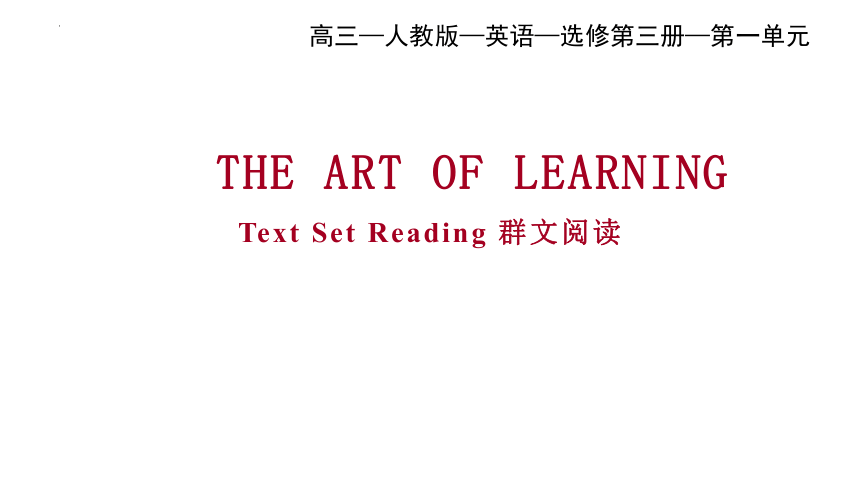 | |
| 格式 | pptx | ||
| 文件大小 | 8.8MB | ||
| 资源类型 | 教案 | ||
| 版本资源 | 人教版(2019) | ||
| 科目 | 英语 | ||
| 更新时间 | 2024-04-14 15:09:59 | ||
图片预览

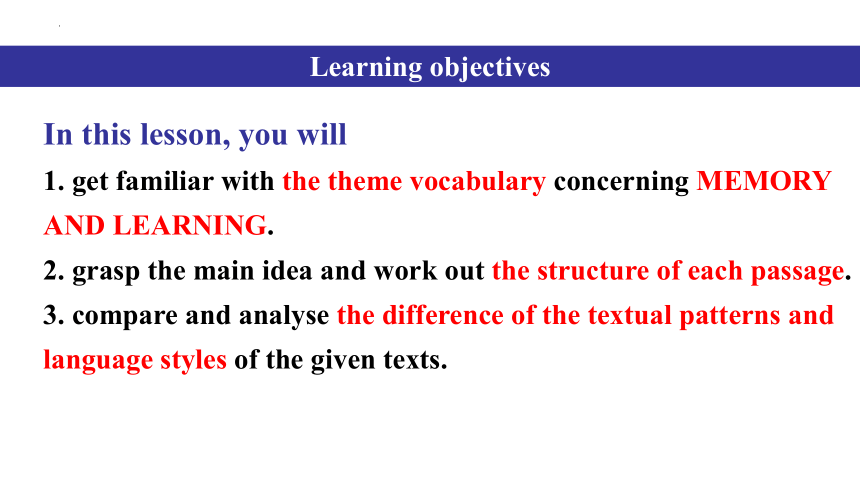
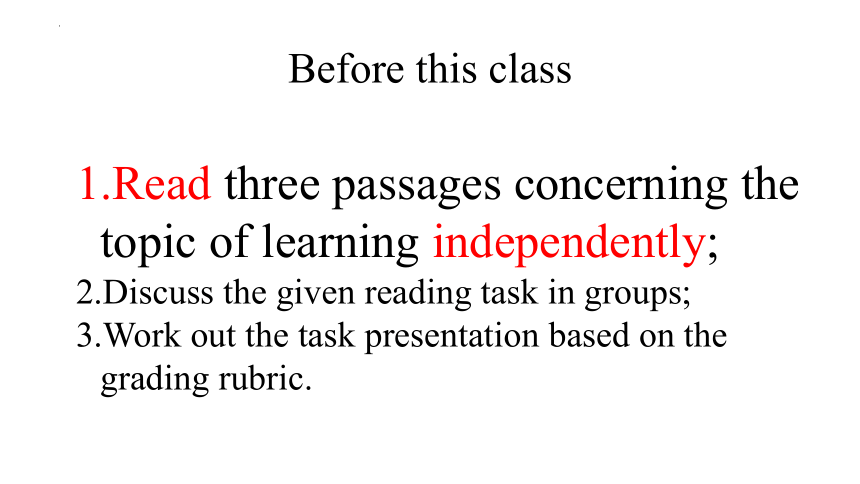
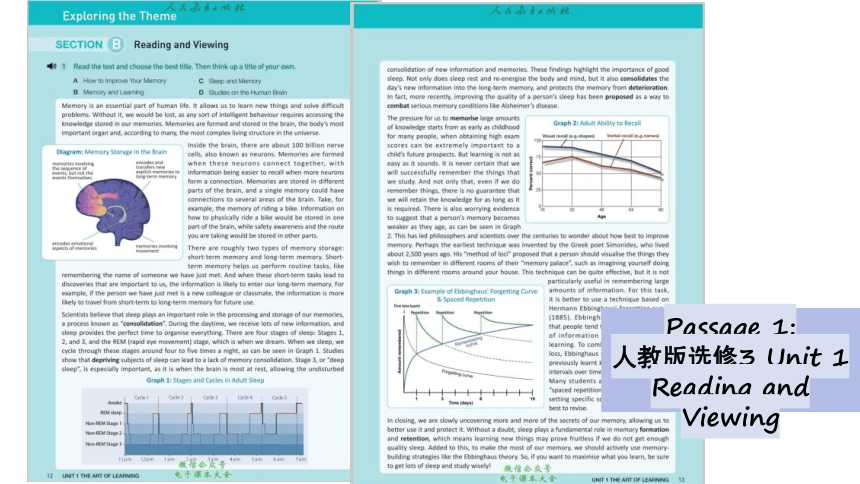
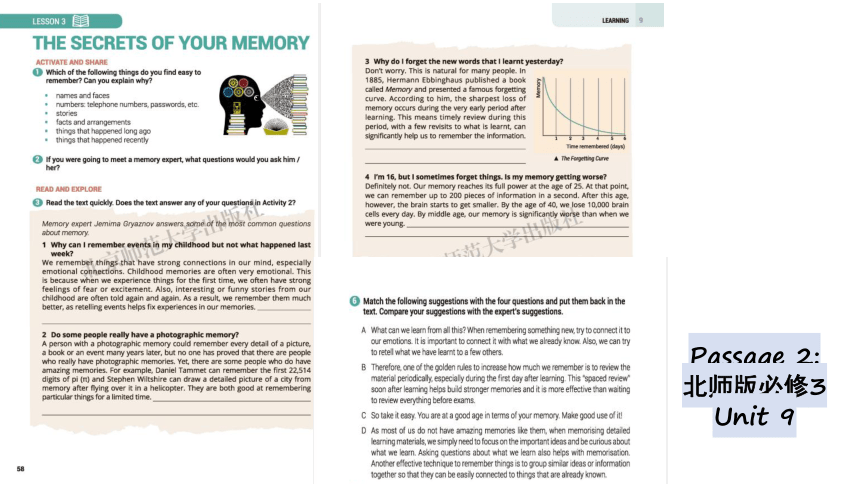
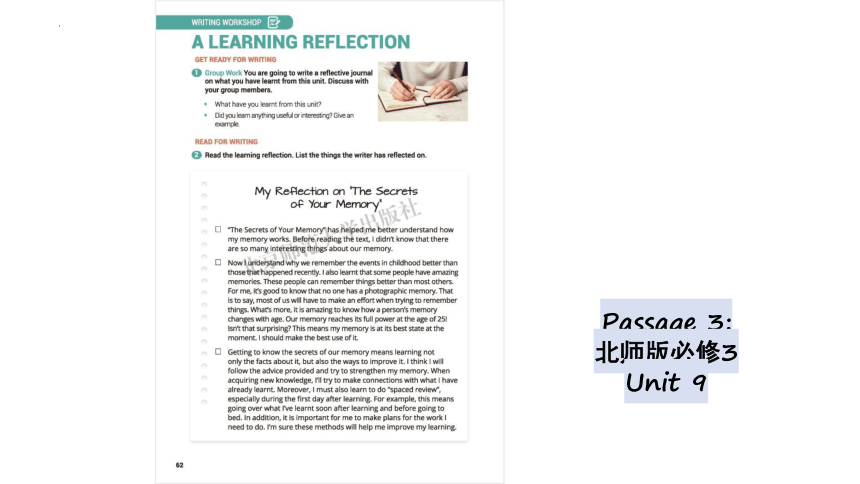
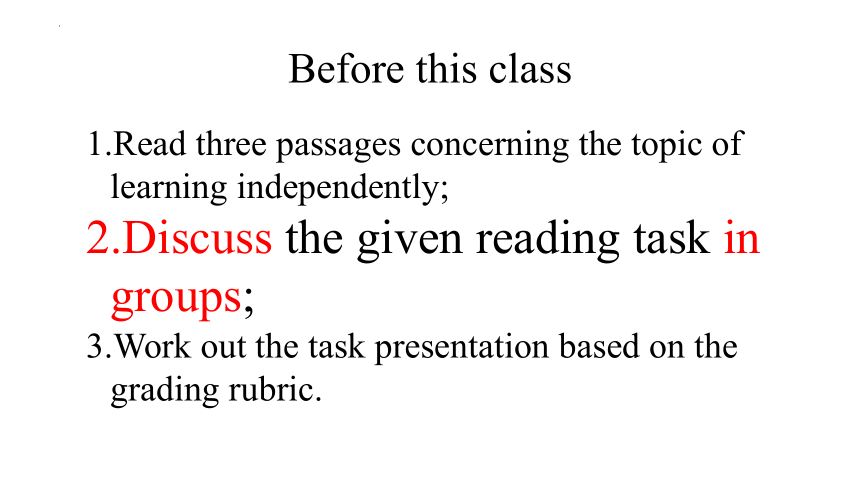
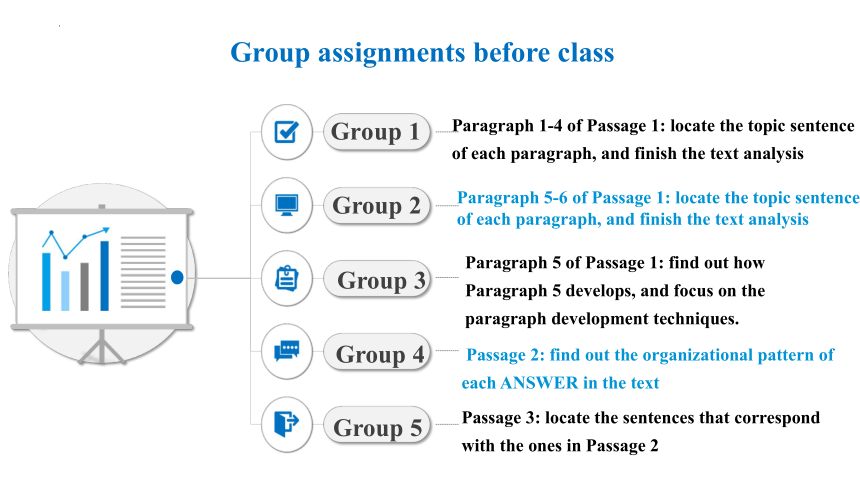

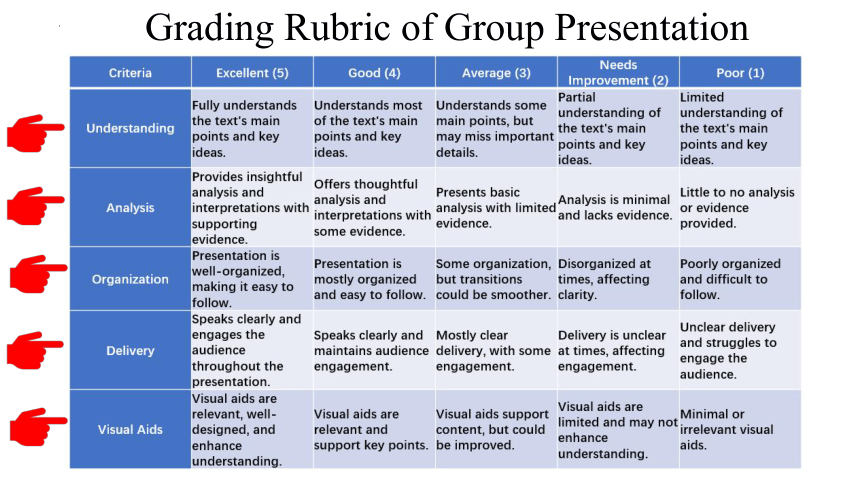
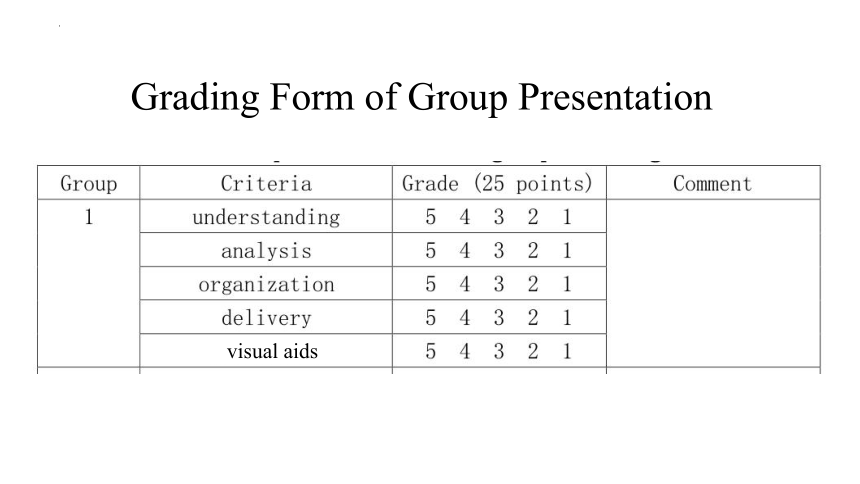
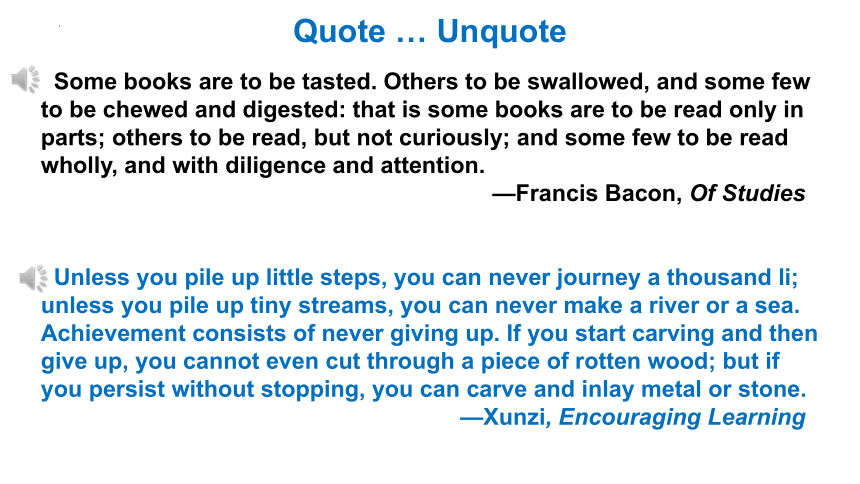
文档简介
(共37张PPT)
高三—人教版—英语—选修第三册—第一单元
THE ART OF LEARNING
Text Set Reading 群文阅读
In this lesson, you will
1. get familiar with the theme vocabulary concerning MEMORY AND LEARNING.
2. grasp the main idea and work out the structure of each passage.
3. compare and analyse the difference of the textual patterns and language styles of the given texts.
Learning objectives
Before this class
Read three passages concerning the topic of learning independently;
Discuss the given reading task in groups;
Work out the task presentation based on the grading rubric.
Passage 1:
人教版选修3 Unit 1 Reading and Viewing
Passage 2:
北师版必修3 Unit 9
Passage 3:
北师版必修3 Unit 9
Before this class
Read three passages concerning the topic of learning independently;
Discuss the given reading task in groups;
Work out the task presentation based on the grading rubric.
Group assignments before class
Group 1
Paragraph 1-4 of Passage 1: locate the topic sentence of each paragraph, and finish the text analysis
Group 2
Paragraph 5-6 of Passage 1: locate the topic sentence of each paragraph, and finish the text analysis
Paragraph 5 of Passage 1: find out how Paragraph 5 develops, and focus on the paragraph development techniques.
Passage 2: find out the organizational pattern of each ANSWER in the text
Passage 3: locate the sentences that correspond with the ones in Passage 2
Group 3
Group 4
Group 5
Before this class
Read three passages concerning the topic of learning independently;
Discuss the given reading task in groups;
Work out the task presentation based on the grading rubric.
Grading Rubric of Group Presentation
Grading Form of Group Presentation
visual aids
Quote … Unquote
Some books are to be tasted. Others to be swallowed, and some few to be chewed and digested: that is some books are to be read only in parts; others to be read, but not curiously; and some few to be read wholly, and with diligence and attention.
—Francis Bacon, Of Studies
Unless you pile up little steps, you can never journey a thousand li; unless you pile up tiny streams, you can never make a river or a sea.
Achievement consists of never giving up. If you start carving and then give up, you cannot even cut through a piece of rotten wood; but if you persist without stopping, you can carve and inlay metal or stone.
—Xunzi, Encouraging Learning
Share with your friends:
Q1: What is your favorite quote about learning
Q2: How do you understand the quotes
Q3: What does the topic “learning” consist of
Quote … Unquote
Quote … Unquote
Some books are to be tasted. Others to be swallowed, and some few to be chewed and digested: that is some books are to be read only in parts; others to be read, but not curiously; and some few to be read wholly, and with diligence and attention.
—Francis Bacon, Of Studies
Unless you pile up little steps, you can never journey a thousand li; unless you pile up tiny streams, you can never make a river or a sea.
Achievement consists of never giving up. If you start carving and then give up, you cannot even cut through a piece of rotten wood; but if you persist without stopping, you can carve and inlay metal or stone.
—Xunzi, Encouraging Learning
The use of a book should be in equal measure to its value.
How we learn effectively
How learning takes place-how memory works
On Learning
01
02
Q3: What does the topic “learning” consist of
General understanding of three passages
01
02
03
04
Read the titles of the three passages
General information of three passages
Genre
Topic
Writing purpose
General understanding of three passages
01
02
03
04
Read the titles of the three passages
Find out the topic sentence in each paragraph in Passage 1
Read aloud the 4 questions listed in the text in Passage 2
Read the first paragraph and the last sentence in Passage 3
Memory
and learning
Different textual patterns
require different reading techniques in catching the main ideas.
General information of three passages
Exposition
Q and A
Reflective journal
Memory and learning
To inform
To answer
To reflect
General learners
Learners who have specific curiosity
Learners who want to apply
Genre
Topic
Writing purpose
01
Detailed Reading of Passage 1
Think and Share
About textual patterns
Q1:What is the textual pattern of the passage
Q2:What necessary means are used to make the paragraphs more cohesive
Q3:How does the author narrow down the topic from memory to individual suggestions
Group presentation
Group 1
Focus
Textual analysis of
Paragraph 1-4 of Passage 1
Group presentation
Group 2
Focus
Textual analysis of
Paragraph 5-6 of Passage 1
Group presentation
Group 3
Focus
Development analysis of
Paragraph 5 of Passage 1
Think and Share
About textual patterns
Q1:What is the textual pattern of the passage
General-specific pattern.
Q2:What necessary means are used to make the paragraphs more cohesive
The repetition of words at the beginning or the end of a paragraph.
The general words like “the processing”, “the storage”.
Pronouns like “this” , “those”.
Q3:How does the author narrow down the topic from memory to individual suggestions
By using problem-solution pattern.
02
Overall Reading of Passage 2
Compare and Share
About textual patterns
Q1: Where and how can you figure out the target readers of Passage 1 and Passage 2?
Q2: What do you think cause the difference in textual patterns
Q3: What are their respective advantages and disadvantages
Group presentation
Group 4
Focus
The organizational pattern of each answer in Passage 2
Presentation example:
Compare and Share
About text patterns
Q1: Where and how can you figure out the target readers of Passage 1 and Passage 2?
Text Target readers Where How
Passage 1 General readers
Passage 2 Learners who have specific curiosity
From the sentence
patterns.
2. From the subjects/personal pronouns.
Suggestions in the last paragraph
The ending advice of each answer
Which wins Information capacity Textual logic Readability
Passage 1
Passage 2
Q2: What do you think cause the difference in textual patterns
Q3: What are their respective advantages and disadvantages
03
Overall Reading of Passage 3
Compare and Share
About text patterns
Q1: With the same information, why are the textual patterns so different
Q2: Whose angle/perspective does Passage 2/3 take
Q3: Do different angles cause any difference in language features If any, please raise some examples.
Group presentation
Group 5
Focus
The sentences in Passage 3 that correspond with the ones in Passage 2
Compare and Share
About text patterns
Q1: With the same information, why are the textual patterns so different
Q 2: Whose angle/perspective does Passage 2/3 take
Passage 2: the angle of an expert
Passage 3: the angle of a learner
Q3: Do different angles cause any difference in language features If any, please raise some examples.
Summary
One minute take away
Q1: What topic have you covered in this lesson
Q2: What reading strategies have you learnt in this lesson
04
03
02
01
Summary
In this lesson, we have learned:
1. theme-related knowledge and vocabulary of MEMORY AND LEARNING;
2. how to analyze textual patterns and compare texts from different angles;
3. how textual patterns are decided and how languages are varied.
Finish 3 passages
concerning the same topic
-memory and learning
Homework
高三—人教版—英语—选修第三册—第一单元
THE ART OF LEARNING
Text Set Reading 群文阅读
In this lesson, you will
1. get familiar with the theme vocabulary concerning MEMORY AND LEARNING.
2. grasp the main idea and work out the structure of each passage.
3. compare and analyse the difference of the textual patterns and language styles of the given texts.
Learning objectives
Before this class
Read three passages concerning the topic of learning independently;
Discuss the given reading task in groups;
Work out the task presentation based on the grading rubric.
Passage 1:
人教版选修3 Unit 1 Reading and Viewing
Passage 2:
北师版必修3 Unit 9
Passage 3:
北师版必修3 Unit 9
Before this class
Read three passages concerning the topic of learning independently;
Discuss the given reading task in groups;
Work out the task presentation based on the grading rubric.
Group assignments before class
Group 1
Paragraph 1-4 of Passage 1: locate the topic sentence of each paragraph, and finish the text analysis
Group 2
Paragraph 5-6 of Passage 1: locate the topic sentence of each paragraph, and finish the text analysis
Paragraph 5 of Passage 1: find out how Paragraph 5 develops, and focus on the paragraph development techniques.
Passage 2: find out the organizational pattern of each ANSWER in the text
Passage 3: locate the sentences that correspond with the ones in Passage 2
Group 3
Group 4
Group 5
Before this class
Read three passages concerning the topic of learning independently;
Discuss the given reading task in groups;
Work out the task presentation based on the grading rubric.
Grading Rubric of Group Presentation
Grading Form of Group Presentation
visual aids
Quote … Unquote
Some books are to be tasted. Others to be swallowed, and some few to be chewed and digested: that is some books are to be read only in parts; others to be read, but not curiously; and some few to be read wholly, and with diligence and attention.
—Francis Bacon, Of Studies
Unless you pile up little steps, you can never journey a thousand li; unless you pile up tiny streams, you can never make a river or a sea.
Achievement consists of never giving up. If you start carving and then give up, you cannot even cut through a piece of rotten wood; but if you persist without stopping, you can carve and inlay metal or stone.
—Xunzi, Encouraging Learning
Share with your friends:
Q1: What is your favorite quote about learning
Q2: How do you understand the quotes
Q3: What does the topic “learning” consist of
Quote … Unquote
Quote … Unquote
Some books are to be tasted. Others to be swallowed, and some few to be chewed and digested: that is some books are to be read only in parts; others to be read, but not curiously; and some few to be read wholly, and with diligence and attention.
—Francis Bacon, Of Studies
Unless you pile up little steps, you can never journey a thousand li; unless you pile up tiny streams, you can never make a river or a sea.
Achievement consists of never giving up. If you start carving and then give up, you cannot even cut through a piece of rotten wood; but if you persist without stopping, you can carve and inlay metal or stone.
—Xunzi, Encouraging Learning
The use of a book should be in equal measure to its value.
How we learn effectively
How learning takes place-how memory works
On Learning
01
02
Q3: What does the topic “learning” consist of
General understanding of three passages
01
02
03
04
Read the titles of the three passages
General information of three passages
Genre
Topic
Writing purpose
General understanding of three passages
01
02
03
04
Read the titles of the three passages
Find out the topic sentence in each paragraph in Passage 1
Read aloud the 4 questions listed in the text in Passage 2
Read the first paragraph and the last sentence in Passage 3
Memory
and learning
Different textual patterns
require different reading techniques in catching the main ideas.
General information of three passages
Exposition
Q and A
Reflective journal
Memory and learning
To inform
To answer
To reflect
General learners
Learners who have specific curiosity
Learners who want to apply
Genre
Topic
Writing purpose
01
Detailed Reading of Passage 1
Think and Share
About textual patterns
Q1:What is the textual pattern of the passage
Q2:What necessary means are used to make the paragraphs more cohesive
Q3:How does the author narrow down the topic from memory to individual suggestions
Group presentation
Group 1
Focus
Textual analysis of
Paragraph 1-4 of Passage 1
Group presentation
Group 2
Focus
Textual analysis of
Paragraph 5-6 of Passage 1
Group presentation
Group 3
Focus
Development analysis of
Paragraph 5 of Passage 1
Think and Share
About textual patterns
Q1:What is the textual pattern of the passage
General-specific pattern.
Q2:What necessary means are used to make the paragraphs more cohesive
The repetition of words at the beginning or the end of a paragraph.
The general words like “the processing”, “the storage”.
Pronouns like “this” , “those”.
Q3:How does the author narrow down the topic from memory to individual suggestions
By using problem-solution pattern.
02
Overall Reading of Passage 2
Compare and Share
About textual patterns
Q1: Where and how can you figure out the target readers of Passage 1 and Passage 2?
Q2: What do you think cause the difference in textual patterns
Q3: What are their respective advantages and disadvantages
Group presentation
Group 4
Focus
The organizational pattern of each answer in Passage 2
Presentation example:
Compare and Share
About text patterns
Q1: Where and how can you figure out the target readers of Passage 1 and Passage 2?
Text Target readers Where How
Passage 1 General readers
Passage 2 Learners who have specific curiosity
From the sentence
patterns.
2. From the subjects/personal pronouns.
Suggestions in the last paragraph
The ending advice of each answer
Which wins Information capacity Textual logic Readability
Passage 1
Passage 2
Q2: What do you think cause the difference in textual patterns
Q3: What are their respective advantages and disadvantages
03
Overall Reading of Passage 3
Compare and Share
About text patterns
Q1: With the same information, why are the textual patterns so different
Q2: Whose angle/perspective does Passage 2/3 take
Q3: Do different angles cause any difference in language features If any, please raise some examples.
Group presentation
Group 5
Focus
The sentences in Passage 3 that correspond with the ones in Passage 2
Compare and Share
About text patterns
Q1: With the same information, why are the textual patterns so different
Q 2: Whose angle/perspective does Passage 2/3 take
Passage 2: the angle of an expert
Passage 3: the angle of a learner
Q3: Do different angles cause any difference in language features If any, please raise some examples.
Summary
One minute take away
Q1: What topic have you covered in this lesson
Q2: What reading strategies have you learnt in this lesson
04
03
02
01
Summary
In this lesson, we have learned:
1. theme-related knowledge and vocabulary of MEMORY AND LEARNING;
2. how to analyze textual patterns and compare texts from different angles;
3. how textual patterns are decided and how languages are varied.
Finish 3 passages
concerning the same topic
-memory and learning
Homework
